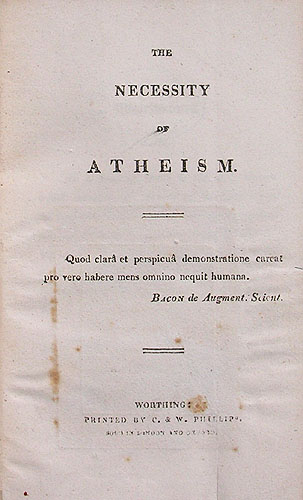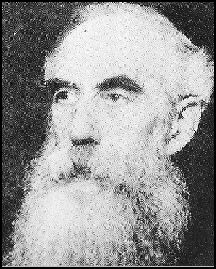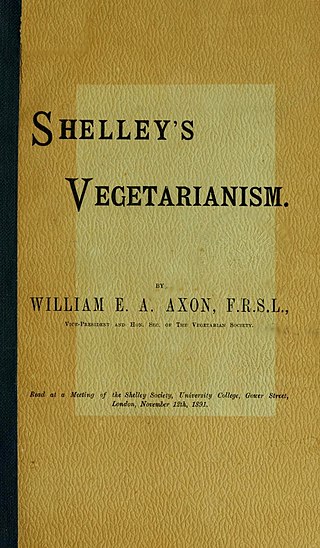Synopsis
Shelley and Hogg presented the poems as being written by Margaret Nicholson herself but which were "edited by her nephew, John FitzVictor" and published after her death. John FitzVictor was not a real person but contrived by Shelley and Hogg. In the play on words he was the son of Victor, intended as an allusion to the co-author of Original Poetry by Victor and Cazire , and the nephew of Margaret Nicholson who had located the poetical fragments. [5] Moreover, Margaret Nicholson was alive at the time of publication and living in Bethlem Hospital. [6]
The work is important because it shows the early political views and radicalism that would evolve in Shelley's later writings. [7] In this work Shelley, in the guise of Margaret Nicholson, attacks the British monarchy as oppressive and burdensome on the people. He expresses his antiwar and antimonarchical views. He blames absolutist and monarchist governments for fomenting wars. These political views would be developed further in Queen Mab in 1812. [7] This work is significant as the earliest expression of Shelley's political radicalism and reformist views. [7]
Shelly perceived "Monarchs" as the "Oppressors of mankind". He wrote: "Kings are but dust—the last eventful day/Will level all and make them lose their sway;/Will dash the sceptre from the Monarch's hand,/And from the warrior's grasp wrest the ensanguin'd brand." Shelley would later more fully develop these political views, in Queen Mab, The Revolt of Islam, and "Ozymandias". This early work is important because it shows the genesis and initial development of Shelley's views on politics and political reform. [8]
Donald H. Reiman and Neil Fraistat in their edition of The Complete Poetry of Percy Bysshe Shelley argued that the work was important because it anticipated Shelley's mature poetry: "The personae whom PBS chose as the author and editor of PF and his method in constructing PF seem to involve a nexus of mutually supportive public and private associations that anticipate (albeit in a crude form) the complex intertwining of traditional myth, literary precedent, historical allusion, scientific knowledge, and personal emotion that characterize his mature poetry" (pp. 240–41). [9]
Margaret Nicholson was a real person who is remembered today chiefly through the Shelley work. She attempted to assassinate King George III in 1786 with a knife. In spite of the title, she was still alive in 1810, dying in Bethlem Royal Hospital on 14 May 1828. Shelley also has a poem on Charlotte Corday who assassinated Jean-Paul Marat in 1793. François Ravaillac, the assassin of King Henry IV of France in 1610, is also a subject of the poem. Shelley, however, uses the real-life Margaret Nicholson only as a starting-off point to develop and to espouse a theory of revolution and emancipation from monarchical rule. The real-life Margaret Nicholson has very little in common with Shelley's fictional recreation; she was evidently unbalanced to the point of insanity. Her motives for the attack were based on a delusion that she was the rightful heir to the throne of England. Shelley is not retelling the story of her life but using it as merely a premise to develop a radical new political theory or vision. This theory would be developed in Shelley's subsequent works such as Queen Mab and the novella "The Assassins". What is important are not the facts of her life but the political views that Shelley would espouse in the work. In this important early work, Shelley presents his theories on political reform and revolution, which would subsequently evolve and develop in his writings. [8]

"Ozymandias" is a sonnet written by the English Romantic poet Percy Bysshe Shelley (1792–1822). It was first published in the 11 January 1818 issue of The Examiner of London. The poem was included the following year in Shelley's collection Rosalind and Helen, A Modern Eclogue; with Other Poems, and in a posthumous compilation of his poems published in 1826.
This article contains information about the literary events and publications of 1810.

"The Necessity of Atheism" is an essay on atheism by the English poet Percy Bysshe Shelley, printed in 1811 by Charles and William Phillips in Worthing while Shelley was a student at University College, Oxford.

"Love's Philosophy" is a poem by Percy Bysshe Shelley published in 1819.

Thomas Jefferson Hogg was a British barrister and writer best known for his friendship with the Romantic poet Percy Bysshe Shelley. Hogg was raised in County Durham, but spent most of his life in London. He and Shelley became friends while studying at University College, Oxford, and remained close until Shelley's death. During their time at Oxford they collaborated on several literary projects, culminating in their joint expulsion following the publication of an essay titled "The Necessity of Atheism". They remained good friends, but their relationship was sometimes strained because of Hogg's attraction to the women who were romantically involved with Shelley.

"Hymn to Intellectual Beauty" is a poem written by Percy Bysshe Shelley in 1816 and published in 1817.
James Augustus St. John, was a British journalist, author, and traveller.

Queen Mab; A Philosophical Poem; With Notes, published in 1813 in nine cantos with seventeen notes, is the first large poetic work written by Percy Bysshe Shelley (1792–1822), the English Romantic poet.
Nationality words link to articles with information on the nation's poetry or literature.

Mont Blanc: Lines Written in the Vale of Chamouni is an ode by the Romantic poet Percy Bysshe Shelley. The poem was composed between 22 July and 29 August 1816 during Shelley's journey to the Chamonix Valley, and intended to reflect the scenery through which he travelled. "Mont Blanc" was first published in 1817 in Percy Shelley and Mary Shelley's History of a Six Weeks' Tour through a Part of France, Switzerland, Germany and Holland, which some scholars believe to use "Mont Blanc" as its culmination.

Percy Bysshe Shelley was one of the major English Romantic poets. A radical in his poetry as well as in his political and social views, Shelley did not achieve fame during his lifetime, but recognition of his achievements in poetry grew steadily following his death and he became an important influence on subsequent generations of poets including Robert Browning, Algernon Charles Swinburne, Thomas Hardy, and W. B. Yeats. American literary critic Harold Bloom describes him as "a superb craftsman, a lyric poet without rival, and surely one of the most advanced sceptical intellects ever to write a poem."

Henry Buxton Forman was a Victorian-era bibliographer and antiquarian bookseller whose literary reputation is based on his bibliographies of Percy Shelley and John Keats. In 1934 he was revealed to have been in a conspiracy with Thomas James Wise (1859–1937) to purvey large quantities of forged first editions of Georgian and Victorian authors.

Margaret Nicholson was an Englishwoman who assaulted King George III in 1786. Her futile and somewhat half-hearted attempt on the King's life became famous and was featured in one of Shelley's first works: Posthumous Fragments of Margaret Nicholson, published in 1810.

Mary Wollstonecraft Shelley was an English novelist who wrote the Gothic novel Frankenstein; or, The Modern Prometheus (1818), which is considered an early example of science fiction and one of her best-known works. She also edited and promoted the works of her husband, the Romantic poet and philosopher Percy Bysshe Shelley. Her father was the political philosopher William Godwin and her mother was the philosopher and women's rights advocate Mary Wollstonecraft.

Original Poetry by Victor and Cazire was a poetry collection written by Percy Bysshe Shelley and his sister Elizabeth which was printed by Charles and William Phillips in Worthing and published by John Joseph Stockdale in September 1810. The work was Shelley's first published volume of poetry. Shelley wrote the poems in collaboration with his sister Elizabeth. The poems were written before Shelley entered the University of Oxford.

"The Devil's Walk: A Ballad" was a major poetical work published as a broadside by Percy Bysshe Shelley in 1812. The poem consisted of seven irregular ballad stanzas of 49 lines. The poem was a satirical attack and criticism of the British government. Satan is depicted meeting with key members of the British government. The poem was modelled on and meant as a continuation of "The Devil's Thoughts" of 1799 by Samuel Taylor Coleridge and Robert Southey. The work is important in Shelley's development and evolution of writings that castigate and criticise the British government to achieve political and economic reform.
The Life of Percy Bysshe Shelley is an unfinished posthumous biography of the Romantic poet Percy Bysshe Shelley that was written by his friend Thomas Jefferson Hogg. The first two of the four planned volumes were released in 1858 to largely unfavourable reviews. Though a few friends of Percy Shelley enjoyed the book, many critics attacked the book for being poorly edited and for portraying Shelley negatively. Though more volumes were planned, they were never published because of the Shelley family's objections to Hogg's treatment of him.

A Vindication of Natural Diet is an 1813 book by Percy Bysshe Shelley on vegetarianism and animal rights. It was first written as part of the notes to Queen Mab, which was privately printed in 1813. Later in the same year the essay was separately published as a pamphlet.

"Poetical Essay on the Existing State of Things" is an essay by Percy Bysshe Shelley published in 1811. The work was lost since its first appearance until a copy was found in 2006 and made available by the Bodleian Library in 2015. The anti-war and anti-imperialist work was intended to raise money for the radical Irish journalist Peter Finnerty, who had been imprisoned for libeling the Anglo-Irish politician Robert Stewart, Viscount Castlereagh, whom he accused of mistreating United Irish prisoners. The work is a precursor to The Masque of Anarchy and "England in 1819".

Shelley's Vegetarianism is a 1891 pamphlet on the vegetarianism of Percy Bysshe Shelley by William Axon, published by the Vegetarian Society. It is a printing of a lecture delivered by Axon before the Shelley Society, at University College in 1890.
















